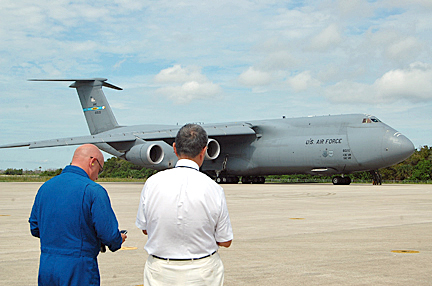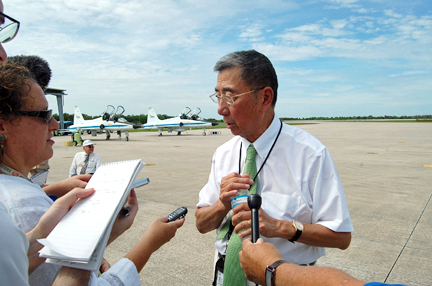$2 billion space station particle detector delivered to Kennedy Space Center
A $2 billion 7.5-ton physics experiment bound for the International Space Station aboard the last planned shuttle flight in February arrived at the Kennedy Space Center Thursday after a busy summer of work to replace the magnet at the heart of the costly particle detector.
With Nobel laureate Samuel Ting, the lead scientist of the AMS project looking on with shuttle commander Mark Kelly and his crew, an Air Force C-5 transport jet taxied to a stop at the Shuttle Landing Facility after a flight from Geneva where the payload was assembled and tested.

Shuttle commander Mark Kelly, left, and Samuel Ting watch the arrival of a
C-5 cargo plane carrying the $2 billion Alpha Magnetic Spectrometer.
(Photo: William Harwood) If all goes well, Kelly and his crewmates will blast off Feb. 26 aboard the shuttle Endeavour to deliver the Alpha Magnetic Spectrometer to the International Space Station. Endeavour's flight is the final shuttle mission currently planned, although NASA managers hope to get funding for one final space station resupply mission next June.
"This is our main payload for this mission," Kelly said at the shuttle runway. "It's also, as far as I can tell, the most expensive piece of the space station that will be installed. So it's pretty exciting for us to be part of this crew and part of this mission.
"The space shuttle was designed to build a space station. And it did not get the opportunity to do that for the first 20 years of its life. Over the last 10 years, it's been very successful assembling this very complex laboratory in space. I think it's fitting that on its last assembly mission, which will be our flight, STS-134, the space station is going to be complete."
Kelly promised Ting that his crew planned to do "everything we can to get AMS successfully installed" on the station's main power truss.
"So Sam, I give you our guarantee we're not going to break it!" Kelly said. "It'll get installed on the truss and hopefully be working before we depart."
The Alpha Magnetic Spectrometer, an international project managed by the U.S. Department of Energy, NASA, the European Space Agency, and other government and academic institutions, is designed to study subatomic particles from deep space in search of antimatter and phenomena that might help explain dark matter, the unseen material making up 90 percent of the matter in the known universe.
The trajectories of high energy cosmic ray particles entering the AMS will be deflected by the instrument's intense magnetic field. Scores of detectors will precisely measure such deflections, allowing scientists to figure out the properties of the subatomic particles in question.

Nobel Laureate Samuel Ting discusses the AMS experiment with reporters
at the Kennedy Space Center. (Photo: William Harwood)
"At the moment there was a big bang, there must be equal amounts of matter and antimatter," Ting said. "Now antimatter has been found in accelerators. The question is, is there a universe far, far, far away made out of antimatter? That is one example. The second example is we know 90 percent of the matter in the universe we cannot see. We know it exists. ... This experiment will provide the most sensitive search for the dark matter."
In the wake of the 2003 Columbia disaster and a decision by the Bush administration to complete the International Space Station and retire the shuttle by 2010, the AMS payload was dropped from NASA's manifest in favor of higher-priority space station components.
But supporters of the project never gave up hope and after intense lobbying, the Obama administration agreed to fund an shuttle flight to deliver the AMS to the space station.
"The largest (particle) accelerator on Earth is 16 miles in circumference, the Large Hadron Collider, LHC," Ting told reporters, referring to the new accelerator built by the European Organization for Nuclear Research, or CERN. "In the LHC, there are four big experiments, thousands and thousands of physicists work there trying to understand the beginning of the universe, what is the origin of mass, why different particles have different masses.
"The cost of ISS is about 10 times more than the LHC," Ting said. "The LHC has four experiments. On the space station, to study particle physics, the origin of the universe, only has AMS. And that's why we're very grateful to the United States House of Representatives and the Senate, which passed the resolution to support NASA to have an additional flight to put us in space."
That flight originally was planned for July, but the AMS team decided to replace the cryogenically-cooled magnet at the heart of the device after the Obama administration cleared NASA to operate the space station through at least 2020.
"We had built a superconducting magnet based on the assumption ... that we would be on space station for three years and space station would be deorbited in 2015," Ting said. "So we tested the magnet. The magnet would last 28 (months), plus or minus six months, close to three years.
"But now at the end of last year, we learned space station would go to 2020 and maybe even go to 2028. So after three years, AMS would become a museum piece. And so we quickly decided to change to a permanent magnet."

A graphic showing the location of the Alpha Magnetic Spectrometer, circled in red, on the International
Space Station's main power truss. (Graphic: European Space Agency)
A less powerful magnet tested during an earlier shuttle flight was pressed into service in place of the superconducting magnet.
"The magnetic field of the permanent magnet from the first flight, it has not changed at all," Ting said. "And so because the permanent magnet has a weaker field, you need to put in more detectors. Since it always had 400 percent redundancy, it was easy for us to put in the detectors.
"Now we have put in more detectors and over the past two weeks we tested extensively in the accelerator at CERN and found the resolution, the sensitivity, is exactly the same as the superconducting magnet."
But the work to swap out the magnets, along with launch conflicts with other station-bound missions, forced NASA to delay Endeavour's flight from July to February.
With Nobel laureate Samuel Ting, the lead scientist of the AMS project looking on with shuttle commander Mark Kelly and his crew, an Air Force C-5 transport jet taxied to a stop at the Shuttle Landing Facility after a flight from Geneva where the payload was assembled and tested.

C-5 cargo plane carrying the $2 billion Alpha Magnetic Spectrometer.
(Photo: William Harwood)
"This is our main payload for this mission," Kelly said at the shuttle runway. "It's also, as far as I can tell, the most expensive piece of the space station that will be installed. So it's pretty exciting for us to be part of this crew and part of this mission.
"The space shuttle was designed to build a space station. And it did not get the opportunity to do that for the first 20 years of its life. Over the last 10 years, it's been very successful assembling this very complex laboratory in space. I think it's fitting that on its last assembly mission, which will be our flight, STS-134, the space station is going to be complete."
Kelly promised Ting that his crew planned to do "everything we can to get AMS successfully installed" on the station's main power truss.
"So Sam, I give you our guarantee we're not going to break it!" Kelly said. "It'll get installed on the truss and hopefully be working before we depart."
The Alpha Magnetic Spectrometer, an international project managed by the U.S. Department of Energy, NASA, the European Space Agency, and other government and academic institutions, is designed to study subatomic particles from deep space in search of antimatter and phenomena that might help explain dark matter, the unseen material making up 90 percent of the matter in the known universe.
The trajectories of high energy cosmic ray particles entering the AMS will be deflected by the instrument's intense magnetic field. Scores of detectors will precisely measure such deflections, allowing scientists to figure out the properties of the subatomic particles in question.

at the Kennedy Space Center. (Photo: William Harwood)
"At the moment there was a big bang, there must be equal amounts of matter and antimatter," Ting said. "Now antimatter has been found in accelerators. The question is, is there a universe far, far, far away made out of antimatter? That is one example. The second example is we know 90 percent of the matter in the universe we cannot see. We know it exists. ... This experiment will provide the most sensitive search for the dark matter."
In the wake of the 2003 Columbia disaster and a decision by the Bush administration to complete the International Space Station and retire the shuttle by 2010, the AMS payload was dropped from NASA's manifest in favor of higher-priority space station components.
But supporters of the project never gave up hope and after intense lobbying, the Obama administration agreed to fund an shuttle flight to deliver the AMS to the space station.
"The largest (particle) accelerator on Earth is 16 miles in circumference, the Large Hadron Collider, LHC," Ting told reporters, referring to the new accelerator built by the European Organization for Nuclear Research, or CERN. "In the LHC, there are four big experiments, thousands and thousands of physicists work there trying to understand the beginning of the universe, what is the origin of mass, why different particles have different masses.
"The cost of ISS is about 10 times more than the LHC," Ting said. "The LHC has four experiments. On the space station, to study particle physics, the origin of the universe, only has AMS. And that's why we're very grateful to the United States House of Representatives and the Senate, which passed the resolution to support NASA to have an additional flight to put us in space."
That flight originally was planned for July, but the AMS team decided to replace the cryogenically-cooled magnet at the heart of the device after the Obama administration cleared NASA to operate the space station through at least 2020.
"We had built a superconducting magnet based on the assumption ... that we would be on space station for three years and space station would be deorbited in 2015," Ting said. "So we tested the magnet. The magnet would last 28 (months), plus or minus six months, close to three years.
"But now at the end of last year, we learned space station would go to 2020 and maybe even go to 2028. So after three years, AMS would become a museum piece. And so we quickly decided to change to a permanent magnet."

Space Station's main power truss. (Graphic: European Space Agency)
A less powerful magnet tested during an earlier shuttle flight was pressed into service in place of the superconducting magnet.
"The magnetic field of the permanent magnet from the first flight, it has not changed at all," Ting said. "And so because the permanent magnet has a weaker field, you need to put in more detectors. Since it always had 400 percent redundancy, it was easy for us to put in the detectors.
"Now we have put in more detectors and over the past two weeks we tested extensively in the accelerator at CERN and found the resolution, the sensitivity, is exactly the same as the superconducting magnet."
But the work to swap out the magnets, along with launch conflicts with other station-bound missions, forced NASA to delay Endeavour's flight from July to February.